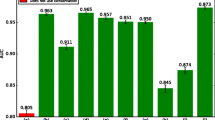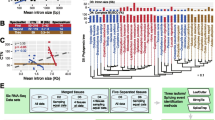Abstract
Alternative pre-mRNA splicing presides over protein diversity and organism complexity. Alternative splicing isoforms in human have been associated with specific developmental stages, tissue-specific expressions and disease-causing factors. In this study, we identified and analysed intrinsic features that discriminate non-conserved human genes that undergo a single internal cassette exon event from constitutively spliced exons. Context-based analysis revealed a guanine-rich track at the donor of the cassette’s upstream intronic region that is absent in the constitutive dataset, as well as significant differences in the distribution of CpG and A3/G3 sequences between the alternative and the constitutive intronic regions. Interestingly, introns flanking cassette exons are larger than the constitutive ones, while exon lengths do not vary significantly. Splice sites flanking cassette exons are less identifiable, while splice sites at the outer ends are ‘stronger’ than constitutive introns. The results indicate that specific intrinsic features are linked with the inclusion/excision of internal exons which are indicative of the underlying selection rules.
Preview
Unable to display preview. Download preview PDF.
Similar content being viewed by others
References
Modrek, B., Lee, C.: A genomic view of alternative splicing. Nat. Genet. 30, 13–19 (2002)
Johnson, J.M., Castle, J., Garrett-Engele, P., Kan, Z., Loerch, P.M., Armour, C.D., Santos, R., Schadt, E.E., Stoughton, R., Shoemaker, D.D.: Genome-wide survey of human alternative pre-mRNA splicing with exon junction microarrays. Science 302, 2141–2144 (2003)
Ast, G.: How did alternative splicing evolve? Nat. Rev. Genet. 5, 773–782 (2004)
Faustino, N.A., Cooper, T.A.: Pre-mRNA splicing and human disease. Genes Dev. 17, 419–437 (2003)
Venables, J.P.: Aberrant and alternative splicing in cancer. Cancer Res. 64, 7647–7654 (2004)
Modrek, B., Resch, A., Grasso, C., Lee, C.: Genome-wide detection of alternative splicing in expressed sequences of human genes. Nucleic Acids Res. 29, 2850–2859 (2001)
Graveley, B.R.: Alternative splicing: increasing diversity in the proteomic world. Trends Genet. 17, 100–107 (2001)
Stamm, S., Zhu, J., Nakai, K., Stoilov, P., Stoss, O., Zhang, M.Q.: An alternative-exon database and its statistical analysis. DNA Cell Biol. 19, 739–756 (2000)
Stamm, S., Riethoven, J.J., Le Texier, V., Gopalakrishnan, C., Kumanduri, V., Tang, Y., Barbosa-Morais, N.L., Thanaraj, T.A.: ASD: a bioinformatics resource on alternative splicing. Nucleic Acids Res. 34, D46–D55 (2006)
Mathe, C., Sagot, M.F., Schiex, T., Rouze, P.: Current methods of gene prediction, their strengths and weaknesses. Nucleic Acids Res. 30, 4103–4117 (2002)
Yeo, G., Burge, C.B.: Maximum entropy modeling of short sequence motifs with applications to RNA splicing signals. J. Comput. Biol. 11, 377–394 (2004)
Shapiro, M.B., Senapathy, P.: RNA splice junctions of different classes of eukaryotes: sequence statistics and functional implications in gene expression. Nucleic Acids Res. 15, 7155–7174 (1987)
Thompson, J.D., Higgins, D.G., Gibson, T.J.: CLUSTAL W: Improving the sensitivity of progressive multiple sequence alignment through sequence weighting, position-specific gap penalties and weight matrix choice. Nucleic Acids Res. 22, 4673–4680 (1994)
Clamp, M., Cuff, J., Searle, S.M., Barton, G.J.: The Jalview Java alignment editor. Bioinformatics 20, 426–427 (2004)
Foissac, S., Schiex, T.: Integrating alternative splicing detection into gene prediction. BMC. Bioinformatics 6, 25–34 (2005)
Rogic, S., Mackworth, A.K., Ouellette, F.B.: Evaluation of gene-finding programs on mammalian sequences. Genome Res. 11, 817–832 (2001)
Burge, C., Karlin, S.: Prediction of complete gene structures in human genomic DNA. J. Mol. Biol. 268, 78–94 (1997)
Pertea, M., Lin, X., Salzberg, S.L.: GeneSplicer: a new computational method for splice site prediction. Nucleic Acids Res. 29, 1185–1190 (2001)
Magen, A., Ast, G.: The importance of being divisible by three in alternative splicing. Nucleic Acids Res. 33, 5574–5582 (2005)
Ladd, A.N., Cooper, T.A.: Finding signals that regulate alternative splicing in the post-genomic era. Genome Biol. 3, 1–16 (2002) (reviews0008)
Sorek, R., Shamir, R., Ast, G.: How prevalent is functional alternative splicing in the human genome? Trends Genet. 20, 68–71 (2004)
McCullough, A.J., Berget, S.M.: G triplets located throughout a class of small vertebrate introns enforce intron borders and regulate splice site selection. Mol. Cell Biol. 17, 4562–4571 (1997)
Clark, F., Thanaraj, T.A.: Categorization and characterization of transcript-confirmed constitutively and alternatively spliced introns and exons from human. Hum. Mol. Genet. 11, 451–464 (2002)
Thanaraj, T.A., Stamm, S.: Prediction and statistical analysis of alternatively spliced exons. Prog. Mol. Subcell. Biol. 31, 1–31 (2003)
Itoh, H., Washio, T., Tomita, M.: Computational comparative analyses of alternative splicing regulation using full-length cDNA of various eukaryotes. RNA 10, 1005–1018 (2004)
Maniatis, T., Tasic, B.: Alternative pre-mRNA splicing and proteome expansion in metazoans. Nature 418, 236–243 (2002)
Author information
Authors and Affiliations
Editor information
Editors and Affiliations
Rights and permissions
Copyright information
© 2006 Springer-Verlag Berlin Heidelberg
About this paper
Cite this paper
Malousi, A., Koutkias, V., Kouidou, S., Maglaveras, N. (2006). Intrinsic Splicing Profile of Human Genes Undergoing Simple Cassette Exon Events. In: Maglaveras, N., Chouvarda, I., Koutkias, V., Brause, R. (eds) Biological and Medical Data Analysis. ISBMDA 2006. Lecture Notes in Computer Science(), vol 4345. Springer, Berlin, Heidelberg. https://doi.org/10.1007/11946465_6
Download citation
DOI: https://doi.org/10.1007/11946465_6
Publisher Name: Springer, Berlin, Heidelberg
Print ISBN: 978-3-540-68063-5
Online ISBN: 978-3-540-68065-9
eBook Packages: Computer ScienceComputer Science (R0)




